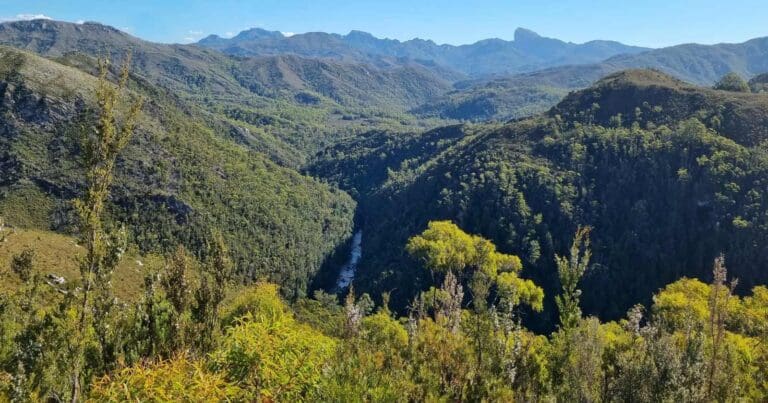Sorry, no records were found. Please adjust your search criteria and try again.
Sorry, unable to load the Maps API.
Explore stunning hiking trails of Franklin-Gordon Wild Rivers National Park
Discover the diverse trails of Franklin-Gordon Wild Rivers National Park, Tasmania, offering hikes and walks for all skill levels and interests. Find your perfect adventure today.
Exploring the Franklin-Gordon Wild Rivers National Park
The Franklin-Gordon Wild Rivers National Park, situated in Tasmania’s west, is renowned for its rugged terrain and dramatic mountain peaks. The park’s rivers, characterised by their tannin-stained waters, meander through stunning gorges, with the Franklin and Gordon rivers being prominent features of the landscape. Water is a constant presence here, cascading from mountain peaks into creeks that wind their way through the rocks.
Located within the Tasmanian Wilderness World Heritage Area, the park is approximately an hour’s drive from Strahan. The Lyell Highway provides convenient access, with short walks offering glimpses of the famed Franklin River. Commercial cruises from Strahan allow visitors to experience the impressive Macquarie Harbour and Gordon River. Despite the park’s remote and rugged nature, several scenic stop-off points along the Lyell Highway offer a preview of the natural beauty that awaits those equipped and fit enough to explore further.
The park is historically significant, known for the major conservation battle fought to protect the Franklin River during the late 1970s and early 1980s. This struggle, which saw a clash between supporters of a hydro-electric power scheme and conservationists, culminated in a High Court ruling on 1 July 1983 that favoured the preservation of the wild rivers.
With an annual rainfall exceeding 1900mm, the park is situated in Tasmania’s wettest region. It supports diverse vegetation, including wet temperate rainforest, buttongrass moorland, and eucalypt forest. This rich environment provides habitat for various native animals, including the Tasmanian devil, spotted-tail quoll, and eastern quoll. Platypus are often seen in the park’s rivers, while echidnas and pademelons are common in the undergrowth.
The park also contains several Aboriginal sites, reflecting the southernmost extent of human habitation during the last ice age. Many of these sites hold significant cultural value for today’s Aboriginal communities, with some, such as Kutikina Cave, returned under the Aboriginal Lands Act 1995.
The colonial history of the region includes a grim chapter related to the penal settlement on Sarah Island, established in Macquarie Harbour in 1822. Escaped convicts inadvertently became some of the first European explorers of the area, with notorious stories of survival and cannibalism by Alexander ‘Cannibal’ Pearce. Convicts were also involved in the Huon pine industry, which lasted over 150 years, and prospecting expeditions during the gold boom of the 1850s led to the development of the western mineral belt. The old Linda Track, cut in 1887, and the Lyell Highway, opened in 1932, both played crucial roles in accessing the region’s resources.
To reach the Franklin-Gordon Wild Rivers National Park, drive west from Hobart for about 2.5 hours along the Lyell Highway. From Launceston, travel south via Longford and Poatina to Miena and then the B11 to Bronte Park, joining the A5. King William Saddle, west of Derwent Bridge, marks the park’s eastern boundary, while Nelson Falls, 56 km further along the highway, marks the western boundary—a 3-hour drive from Hobart. The park can also be accessed by daily cruise boats from Strahan, though visitors should be aware that the Lyell Highway may be closed by snow in winter.
Want to find the best tracks and trails for an adventurous hike, casual walk, or a family trip? Trail Hiking Australia has the best trails for walking, hiking, running, and more.
Share an official trail
Know of an official trail that’s not yet on Trail Hiking Australia? Official trails are those recognised and managed by government park agencies or land managers. Share it with the community! Your contribution helps fellow adventurers discover and safely explore new tracks and trails.
Submit trail







